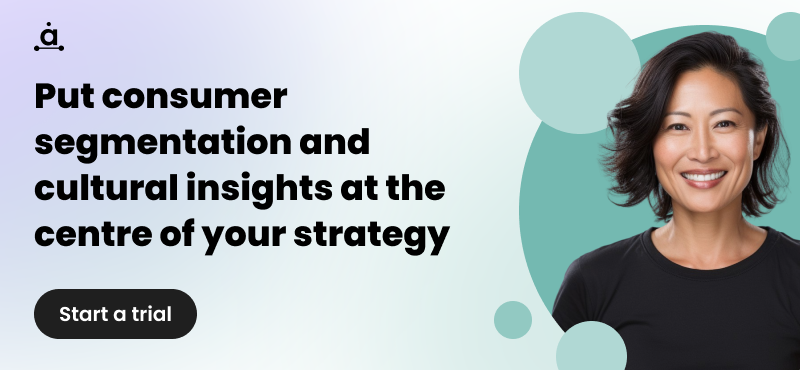Qu'est-ce que la segmentation démographique des médias sociaux ? | Guide de l'utilisateur
La segmentation démographique des médias sociaux est un moyen de segmenter votre audience sur la base de données démographiques telles que l'âge, le sexe et la localisation. Ces informations, superposées à d'autres données d'audience telles que les données psychographiques et les affinités, peuvent contribuer à éclairer vos stratégies de promotion des médias sociaux et du contenu, afin que vous sachiez exactement qui cibler sur chaque plateforme. Dans ce guide, nous expliquons l'importance de combiner les données démographiques avec d'autres types de segmentation pour créer une approche hautement efficace et culturellement pertinente.
Types de segmentation démographique
L'âge
L'âge peut être un facteur utile à prendre en compte lorsqu'il s'agit de décider des plateformes de médias sociaux sur lesquelles mener vos campagnes ou de déterminer le type de campagnes à mener. Par exemple, l'analyse des données démographiques relatives à l'âge peut révéler que vos adeptes sont nettement plus âgés ou plus jeunes que vous ne l'aviez supposé, ce qui peut modifier le message, le concept ou la stratégie de promotion de vos campagnes.

Audiense fournit une ventilation complète de l'âge pour chaque segment de votre audience. Comme vous le voyez dans l'exemple ci-dessus, l'audience la plus importante est celle des 18-24 ans, suivie de celle des 25-34 ans. Il est intéressant de noter que la répartition des 35-44 ans et des 45-54 ans est nettement plus importante que la base de référence, et qu'il s'agit donc d'un segment clé à prendre en compte.
Genre
L'intelligence de l'audience est particulièrement pertinente lorsqu'il s'agit du genre, car elle permet d'éviter que des décisions mal informées et des stéréotypes de genre ne s'insinuent dans le marketing des produits.
Dans Audiense Insights, vous pouvez accéder à une ventilation détaillée par sexe de votre audience afin de comprendre la répartition des hommes et des femmes au sein de votre audience. Bien qu'utiles, il est important d'examiner les données démographiques telles que le sexe et l'âge de manière globale et dans le contexte d'un segment plus large afin de comprendre votre audience de manière plus approfondie, car se concentrer uniquement sur les données démographiques peut être réducteur.

Localisation
La segmentation de votre public par pays ou par ville est extrêmement utile pour le ciblage des médias payants et l'allocation des budgets aux différentes campagnes en conséquence. Le fait de savoir où votre audience est basée peut également vous aider à prendre en compte les considérations culturelles dont vous devez tenir compte lorsque vous faites du marketing dans des régions spécifiques. Avec Audiense Insights, vous voyez comment votre audience est répartie au niveau du pays et, de manière plus granulaire, au niveau de la ville.


Les limites de la segmentation démographique
La segmentation démographique peut être un bon point de départ pour cerner votre public et développer une compréhension de base des personnes qui suivent votre marque, mais elle a ses limites. Les données démographiques telles que l'âge et le sexe sont principalement déduites sur la base d'hypothèses et du comportement des consommateurs, c'est-à-dire des comptes qu'ils suivent et avec lesquels ils interagissent. La superposition de ces données avec d'autres intérêts ou informations psychographiques peut donc aider à dresser un tableau plus complet et plus précis de votre public.
En outre, de plus en plus de consommateurs ne veulent plus être définis par des caractéristiques fixes telles que l'âge, le sexe ou la race. Au lieu de cela, 65 % se définissent par leur personnalité, le même pourcentage par leurs valeurs et 58 % par leurs loisirs, selon Relationships : A Status Update de VICE. À peine 9 % des personnes interrogées estiment qu'elles devraient être définies par l'expression de leur sexe, et un pourcentage encore plus faible, 7 %, par leur âge.

En regroupant votre public par sexe, âge ou localisation, vous supposez que tous les utilisateurs du segment sont intrinsèquement similaires et qu'ils aiment donc les mêmes choses, ce qui n'est tout simplement pas le cas. Alors, comment aller plus loin ?
Comment Audiense apporte-t-il une solution à ce problème ?
En d'autres termes, la segmentation démographique n'offre pas une vue d'ensemble ; elle n'est qu'un des nombreux éléments qui composent votre public. L'intelligence de l'audience, en revanche, crée une vue holistique en temps réel qui vous permet de comprendre qui compose votre audience, sa personnalité, ce qu'elle aime, ses habitudes en ligne et ce qui la motive.
Identifier les communautés connectées

Au lieu de déduire les intérêts des audiences et de les regrouper en conséquence, Audiense propose une approche différente de la segmentation des consommateurs sur les médias sociaux, vous permettant de comprendre ce qui rend chaque segment d'audience unique. Audiense regroupe les personnes en fonction de leurs liens avec les autres membres de l'audience, puis détermine les affinités ou les comportements qui les rendent uniques. En combinant ainsi plusieurs couches de données d'audience, vous pouvez créer des campagnes hautement personnalisées et bien informées qui trouvent un réel écho auprès de votre public.
Transformez votre façon de prendre des décisions et découvrez de nouvelles opportunités avec Audiense Insights.
Pour en savoir plus sur la magie du regroupement des publics, cliquez ici.
Essayez gratuitement Audiense Insights.







